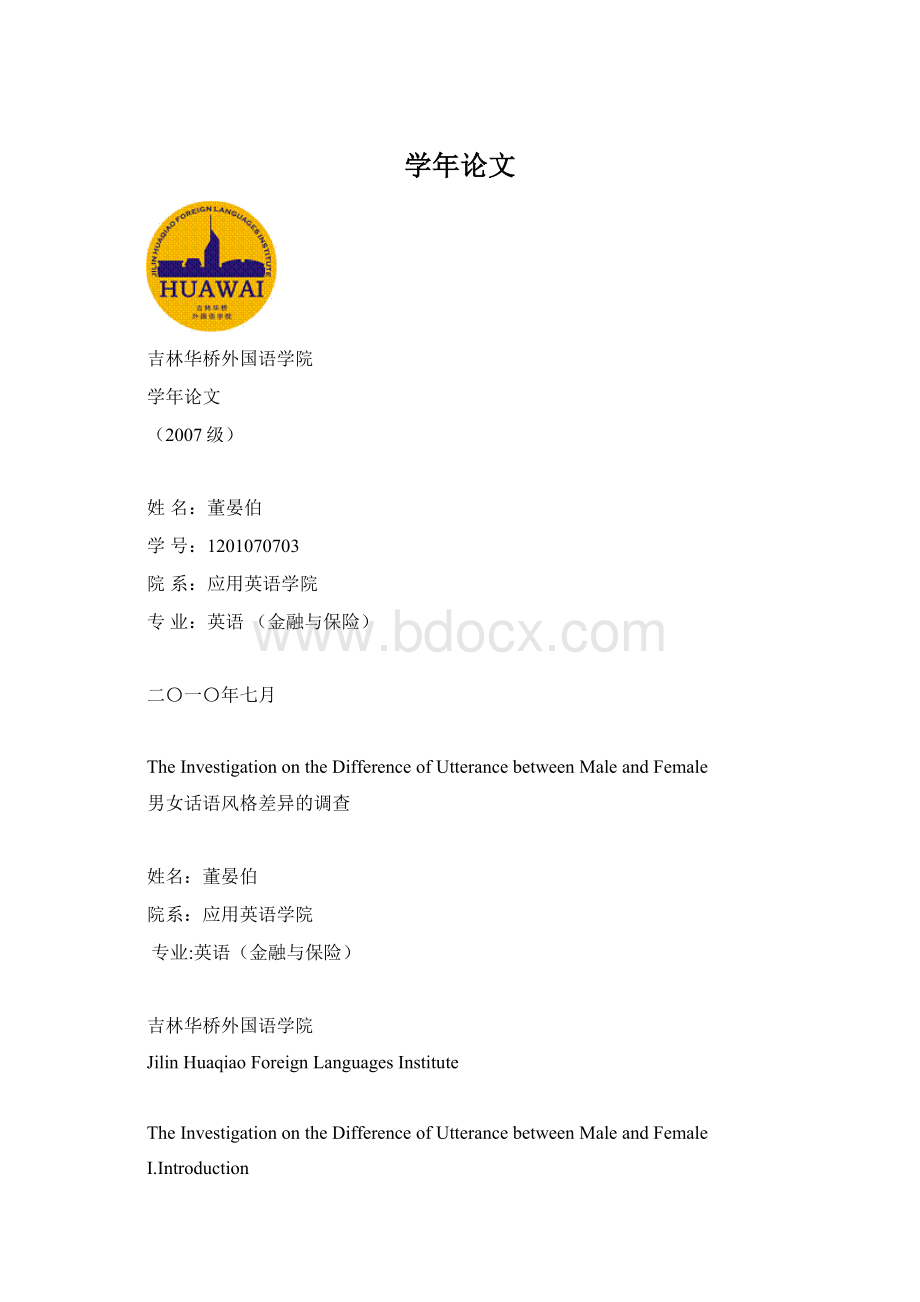学年论文.docx
《学年论文.docx》由会员分享,可在线阅读,更多相关《学年论文.docx(8页珍藏版)》请在冰豆网上搜索。

学年论文
吉林华桥外国语学院
学年论文
(2007级)
姓名:
董晏伯
学号:
1201070703
院系:
应用英语学院
专业:
英语(金融与保险)
二〇一〇年七月
TheInvestigationontheDifferenceofUtterancebetweenMaleandFemale
男女话语风格差异的调查
姓名:
董晏伯
院系:
应用英语学院
专业:
英语(金融与保险)
吉林华桥外国语学院
JilinHuaqiaoForeignLanguagesInstitute
TheInvestigationontheDifferenceofUtterancebetweenMaleandFemale
Ⅰ.Introduction
TheInvestigationontheDifferenceofUtterancebetweenMaleandFemale .InfactIusethekeyword“sex”inmypaperratherthan“gender”,thecurrentone,atfirst.Ipreferrednottousethewordgenderbecauseitwastechnicalterminlinguistics,andmostoftheissuesdealtwithinoursocietyfocusedon“sexism”.However,thecurrentvogueistouse“gender”ratherthan“sex”forthetopicsdiscussedtoday,andIhavethereforeadoptedithere.Furthermore,thesexnormallyreferstobiologicalandphysicaldifferencesbetweenthemaleandfemale,whereasgenderinvolvesmoresocialandculturalelementsinvolvingthewholegamutofsocialandculturaldifferencesbetweenthemaleandfemale.Therefore,inthisviewgenderrolesratherthansexrolesshouldbetheconcernindiscussion.
Ⅱ.TheOriginandEvolutionofGenderDifferencesinLanguage
2.1TheOriginofGenderDifferencesinLanguage
Languageisanencyclopediaofstudyingthesocialbehavior;languageisalivingfossilofrecordingthesociallife,whichisaffectedbytheviewsandvaluesofsociety.Infact,languageitselfcannotbeeithergoodorbad,whichservesnotonlyasamirrorofourwholesocietybutexpressesandreflectsthewholesocialreality.Genderdifferenceexistinginlanguageisalinguisticphenomenonandisboundupwiththesocioculturalorigin.InthelinguisticliteratureperhapsthesemostfamousexamplesoflinguisticdifferentiationbetweenthesexesisfoundintheLesserAntillesoftheWestIndiesamongtheCaribIndians.“ItisreportedthatmaleandfemaleCaribsspokedifferentlanguages,theresultofalong-agoconquestinwhichagroupofinvadingCarib-speakingmenkilledthelocalArawak-speakingmenandmatedwiththeArawakwomen.ItissaidthatthedescendantsoftheseCarib-speakingmenandArawak-speakingwomenhavebeendescribedashavingdifferentlanguages,becauseboyslearnCaribfromtheirfathersandgirlslearnArawakfromtheirmothers.”①Thisspecificphenomenonofusingdifferentlanguagesbybothmenandwomeninthesametribe,whichclaimsofthegenderdifferenceinlanguage,isoriginatedinalong-agosociety.
2.2TheEvolutionofGenderDifferencesinLanguage
In1975,RobinLakoff,arepresentativeofthistheoryexpressesherideainherworksLangueandWomen’sPlace.Shearguesthatpeopleusedifferentvariantsoflanguage,whichexpressestheinequalityoftheirrolesinsociety.Inheropinion,inthemale-dominantsociety,thespeechmadebymaleisvaluedasstandard,whilethatoffemaleisdeprivedfromthatofmale.Itimpliesthefemaleregardthemselvesasinferiorstotheoppositesex.
However,thistheoryhasbeendoubtedsincewiththedevelopmentofhumansociety.Asthewomenliberationrisessharply,manychangeshavebeentakenplaceinthefieldofwomen’srole.Thelinguisticsnoticedthatthestyledifferencesinthemaleandfemaleconversationarealsoconstrainedbysuchdiscoursestylesassetting,topic,amountofutterance,andsocioculturalconventions,etc.ratherthanonlygender.Thoughthereexistthedisputesbetweenbinarythinkingandpluralisticthinkingonstudyoflanguageuseandgendertoday,sociolinguisticstudyfallsintothelattercategory,andanewschoolappearsgradually.Therefore,maleandfemalediscoursestylesshiftfromstatic-and-macroresearchtodynamic-andmicroresearchinlanguageuseandgenderstudy.
Ⅲ.GenderDifferencesinLinguisticLevel
3.1PhonologyandIntonation
Thedifferencesofphonologyandintonationarepartlydecidedbythephysiologicalstructuraldifferences,andpartlyrestrictedbythefactorssuchastraditionalculture,socialeconomicstatus,speakers’personalities,andcommunicationalbackground.②
Phonologicaldifferencesbetweenthespeechofmenandwomenhavebeennotedinavarietyoflanguages.InmodernEnglishphonology,thefemalevoiceusuallyhasdifferentcharacteristicsfromthemalevoice.Take“soft”asaninstance,femaleusuallypronouncesitas[soft],maleas[so:
ft].Anotherexample,“girl”iscalleda[gεəl]byfemale;[gз:
l]bymale.“InScotlandschoolgirlspronounce‘t’inwordslike‘water’andgotmoreoftenthanschoolboys,whoprefertosubstituteaglottalstop.InMontrealmanymorementhanwomendonotpronouncethe‘l’inthepronounsandarticlesil,elle,la,andles.”③
Theintonationpatternsofmenandwomenalsohavedifferences.ThereisaveryinterestingexamplefromanEnglishwomanwhowasadvisedtospeakmorelikeamaninordertofillapositionthatpreviouslybelongstomen.MargaretThatcherwastoldthathervoicedidnotmatchherpositionasBritishPrimeMinister:
shesoundedtoo“shrill”.Shewasadvisedtolowerhervoice,spokemoreslowly,andadoptedanauthoritativespeakingstyle.Itoccurredtoherthatshecouldmakehernewstyleakindoftrademark,oneeitherwelllikedbyheradmiresordetestedbyheropponents.
Furthermore,womenusecertainpatternsassociatedwithsurpriseandpolitenessmoreoftenthanmendo.“Lakoffsayswomenmayansweraquestionwitharisingintonationsentencepatternusuallyassociatedwithaquestionratherthanthefallingintonationsentencepatternassociatedwithmakinganaffirmativestatement,”④e.g.,
Husband:
Whenwilldinnerbeready?
Wife:
(usingthisrisingintonationpattern)Oh...aroundsixo’clock...?
AccordingtoLakoff,womendothisbecausetheyarelesssureaboutthemselvesandtheiropinionsthanmen,sothattheyusearisingintonationpattern.Incontrast,menusuallytendtousehighfallingintonationattheendofsentences,sothattheirvoicesoundsresoluteandaffirmative.Forexample,
Iwishyou’dtryit. Male:
_ — _ \ _
Female:
_ — _ ∕ _⑤
Accordingtothe“doublevaluestandards”,men’ssocialvalueisdecidedbytheirvirtualability,whiletheirmannerandbehaviorarenotextremelyimportant.Butwomen’ssocialvalueisdeterminedbytheirappropriateandgracefulimages.Asanexternalexpressionwomen’sspeechactbecomesaveryimportantsocialvaluetoappraiselanguagepoliteness,appropriatespeakingstyle,andspeechstrategy,whichthenbecometheconcretecontentandrequestofwomen’ssocialbehaviorstandards.
3.2Lexicology
Intheareaoflexicology,manyofthestudieshavefocusedonEnglish.InEnglish,Lakoffclaimsthatwomenaresensitivetocolorwordsbutmostmendonot.AndthroughNowaczyk’sexperiment,theresultshowsthatmenusuallyuserestrictedcolortermsratherthanelaboratedcolortermslikemauve,beige,aquamarine,lavender,taupe,andmagenta,whichisusuallyadoptedbyfemaleusually.
Lakoffalsomaintainsthatadjectivessuchasadorable,charming,divine,lovely,andsweetarealsocommonlyusedbywomenbutonlyveryrarelybymen.Womenarealsosaidtohavetheirownvocabularyforemphasizingcertaineffectsonthem,wordsandexpressionssuchassogood,fun,lovely,divine,precious,darling,andfantastic.
Euphemismisoneofthemostimportantrhetoric,existinggenerallyinlanguages.Itisakindofself-defendingandself-comfortingdesiretomanypeople,especiallytofemale.AninterestingexamplesaysthatthereisapersonvisitedaMadame’shusband,buttheMadametoldthefriendherhusband“isburningwithalowblueflame”,thatistosayherhusbandwasdrunk.Touseeuphemismcandodgeembarrassingexpressionforwomen.Asfollowingexamples:
⑴Ihavetogopowdermynose.→
Ineedtousethewashroom.
⑵Johnsmokesapackofcigarettesaday.→
Johnsmokesalotofcigarettes.
Theuseofeuphemismalsohasgreatdifferentbetweenmaleandfemale.Themaleliketousenit,dawn,piss,fuck,andblasttoshowtheircurse;butfemalealwaystrytheirbesttoavoidthesewordsbyuseofOhdear,Goodness,Gracious,Dearme,etc.,forexample,
Female:
Ohdear,you’veputthepeanutbutterintherefrigeratoragain.
Male:
Shit,you’veputthepeanutbutterintherefrigeratoragain.
Therecertainlyaregenderdifferencesinvariouslanguagesinlexicology.WewilllookatsomeoftheevidencethattherearegenderdifferencesinJapanese.Amaledescribehimselfas“boku”whereasafemaleuse“watasi”or“atasi”toshowtheyarewomenwhentheyspeak.Usuallywomenandchildrenuse“wa”or“kasira”toendasentence,butmenseldomdothat;theyusuallyuse“ne”or“kana”.
3.3Syntax
Inmaleandfemaleverbalcommunication,Lakoffclaimsthatbecausewomenarelesssureandaffirmativeofthemselvesandtheiropinionsthanmen.Theyoftenliketoaddtagquestiontostatement,e.g.,“Hecan’tdothat,canhe?
”,“Thatwasprettysilly,wasn’tit?
”.Ontheotherhand,theuseoftagquestionbyfemalecanachievethreegoodeffectsasfollows:
Firstly,itmayconfirmwhethertheinformationreliability,e.g.,“Johnwasill,wasn’the?
”.Secondly,itmaysoftentheexpression,e.g.,“Passthebooktome,willyou?
”.Thirdly,thespeakerisexpectedtogivethehearerasignal:
itisyourturnyoutosayatthepresent.Itcanimpeltheconversationtomoveforward,e.g.,“Itisreallyaniceday,isn’tit?
”.Tagquestioncanprovideenoughinformation,andmaketheirowntopiccanbeacceptedbyotherswhocansimplyuse“yes”or“no”toreplyeven.Besides,femaleprefertopronouncelike“we”and“you”assubjecttoshowtheirconsiderationandcareinconversation,e.g.,“Wewillgiveyouourbestservice.”Sometimestheyals